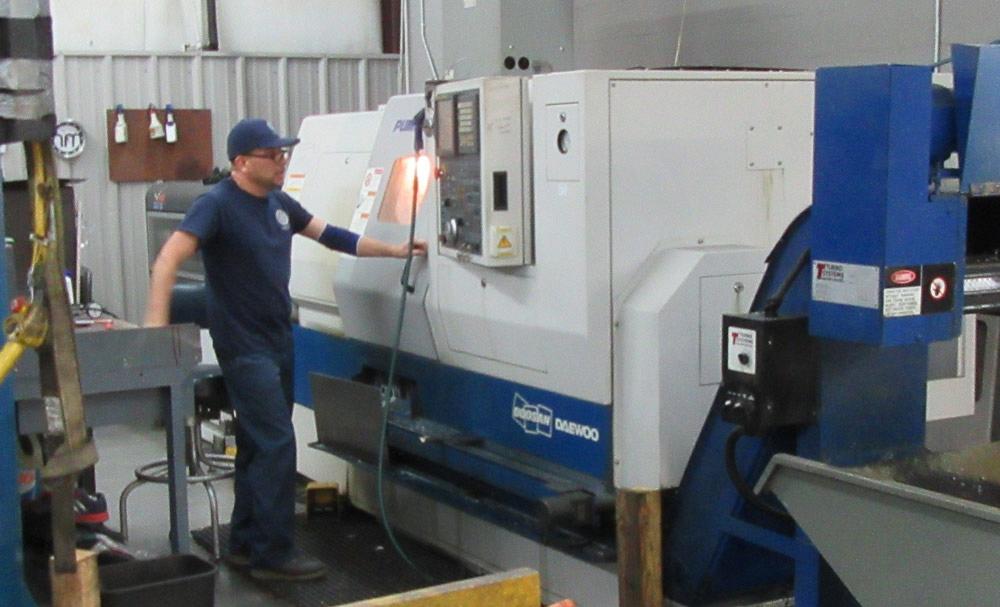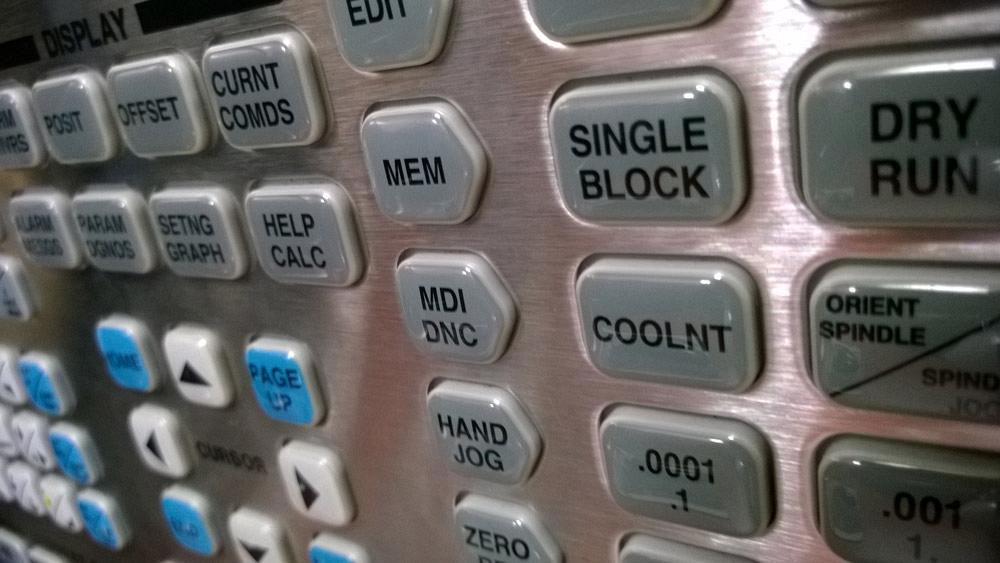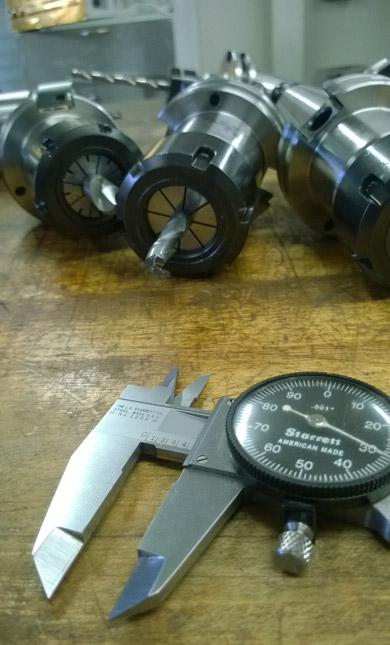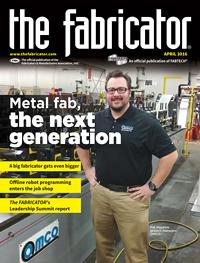Senior Editor
- FMA
- The Fabricator
- FABTECH
- Canadian Metalworking
Categories
- Additive Manufacturing
- Aluminum Welding
- Arc Welding
- Assembly and Joining
- Automation and Robotics
- Bending and Forming
- Consumables
- Cutting and Weld Prep
- Electric Vehicles
- En Español
- Finishing
- Hydroforming
- Laser Cutting
- Laser Welding
- Machining
- Manufacturing Software
- Materials Handling
- Metals/Materials
- Oxyfuel Cutting
- Plasma Cutting
- Power Tools
- Punching and Other Holemaking
- Roll Forming
- Safety
- Sawing
- Shearing
- Shop Management
- Testing and Measuring
- Tube and Pipe Fabrication
- Tube and Pipe Production
- Waterjet Cutting
Industry Directory
Webcasts
Podcasts
FAB 40
Advertise
Subscribe
Account Login
Search
How fabricators manage machining
Bringing in milling and turning requires a well-thought-out strategy
- By Tim Heston
- March 31, 2016
- Article
- Machining
Walk into nearly any custom metal fabricator and you’ll probably see some level of machining. Many don’t have much, perhaps a manual mill or lathe, maybe a vertical machining center (VMC). How much milling and turning a shop has depends largely on how the shop launched in the first place. Some fabricators began as stampers with a tool and die department, and that machining capability never left.
In many cases, the machining is there to support the metal fabrication, with machinists building custom tools and fixtures and perhaps creating small parts that go into larger subassemblies. At the other end of the spectrum, some companies do sell themselves as being a true one-stop shop, with both extensive machining and fabricating capacity.
These days many fall somewhere in between the two extremes. They never expect machining to dominate the business, but their machinists do a little more than just support the primary metal fabrication operation. Put another way, fab shops are stepping their machining departments up a notch.
This month The FABRICATOR spoke with managers at two custom fabrication companies that have approached machining in their own ways: One runs it as a separate department, almost a company within a company; and another treats machining as a growing extension of their broader custom fabrication business.
Adding Value to Fabrication
Webco Manufacturing Inc. got into machining the same way a lot of custom fabricators did: Customers asked for it. Before 2005 the shop outsourced what little machining it had; but as customers ramped up the demand for milling and turning, it made sense to bring the process in-house. “Our customers had sensitive, time-critical parts,” said Mike Johnson, vice president of the Olathe, Kan.-based company.
Webco invested first in a VMC, which is not unusual for a fab shop. But then managers decided to invest in a larger horizontal machining center (HMC). It then purchased a CNC turning center and fitted it with an automatic bar feeder and cutoff. This has allowed the company to offer its customers more options.
“We do a fair amount of upfront collaborations,” Johnson said. “Many times having both the horizontal and vertical [machining centers] gives us flexibility. We can evaluate all options.”
Johnson clarified the company’s strategy. “All the machining we do adds value to our fabrication business.
The machining department may help make fixturing for the company’s welding and assembly areas, but it usually does not double as a toolmaking operation, especially for complex work. “We’re not going to perform complex tool and die work, because by doing that, we’d tie up our machining capacity,” Johnson said.
One element that does not tie up machining capacity is programming. Webco’s machining centers are all programmed offline and then downloaded to the machine control. “Because we do programming on the front end, operators can download that program, put parts in the machine, and they’re good to go.”
This, he said, has helped scheduling greatly. Say an assembly has several cut plates and a machined component that goes into a weldment. “In this case, we can run operations concurrently,” Johnson said. “As we’re doing laser and brake work, we can be machining parts that will be welded.”
Webco does employ specialists who program the machine, of course, but because of the offline programming, operators need not have the same level of machining knowledge. Moreover, the company cross-trains extensively. Webco has several modern press brakes with controls showing 3-D animations of a part being formed. “The [press brake] controls have 3-D models right at the console,” Johnson said. “It’s all very visual, which has helped us out quite a bit. It’s similar to the solid models you see at the machining centers.
“The machining work isn’t as easy as just pushing a button,” Johnson continued. “But because we program offline, the process is so much easier now than it was a few decades ago.”
Where Webco places its machining department shows how machining has remained an integral part of the company, but still separate from its core fabrication processes. Until recently Webco had outgrown its original space and then some, operating out of 125,000 square feet over several buildings.
In 2013 the company moved everything under one roof inside a 200,000-square-foot-facility, with a clear line of sight from one end to the other. Now, at long last, people could see where jobs were coming from and where they were going.
Still, Webco didn’t just move into the space without good planning. Several years ago managers worked with Shahrukh Irani (then at Ohio State but now principal of Lean & Flexible LLC, www.leanandflexible.com) to determine product families with similar routings, and then designed machine layouts around them. Certain repeatedly ordered products, such as some for the rail industry as well as a few more for material handling and power utility sectors, flow through multiprocess cells—though all machining remains in a separate department. A new automated powder coating line has helped improve part flow even more.
“We designed the building with the future in mind,” Johnson said. “There’s a clear line of sight, and we have conduit and electrical wired up for additional machines, such as more laser cutting systems.”
Changes are also afoot in the front office. “We’re in the process of restructuring how sales interacts with front-office personnel,” Johnson said, explaining that previously sales shepherded a job from its initial quote to final production and collections.
“Now we’re reorganizing so that salespeople work with a team of estimators, engineers, and manufacturing experts. The salesperson still will be the point person [for the customer], but they will refer back to a team of experts. It will free sales to prospect and find business.”
This approach will also help with projects that require a variety of manufacturing processes, including machining. In one sense, this shows that it takes more than just investing in a bunch of CNC machining centers. It also takes strategic thinking about how those machining centers fit into the overall business.

A machinist monitors a job in the machining department of Crow Corp., a metal fabricator north of Houston.
A Business Within a Business
Another custom fabricator, Crow Corp., took a different path with its machining, but one no less strategic. Crow’s half-dozen machinists produce a significant amount of machining-exclusive work, along with work that’s part of larger fabricated assemblies. They also produce fixtures and tooling to support the larger fabrication operation.
The 54-year-old company began in stamping, shearing, and tool and die work, then transitioned to CNC fabrication equipment in the 1980s. The shop operated near downtown Houston until 1996, when it moved to a new facility in the northern suburb of Tomball, Texas.
As Keith Jennings, company president, recalled, “When we brought the company here, it proved to be the best move for us.”
The new facility gave the company room to expand, and this included a newly expanded machining department. “That’s when we dramatically expanded our CNC machining department,” Jennings said. “Before the move, we did only light machining work, and we sold it as a value-add [to our fabrication business]. In our current location, we got connected with high-caliber machinists and programmers.”
Of course, it wasn’t all smooth sailing. Being in the Houston metro area, Crow has endured the frenzy of the oil and gas boom followed by the pain of the bust. Through it all, the demand for machined parts has remained relatively stable, at least compared to the fabrication portion of the business.
The boom several years ago had its own challenges, though. “A year and a half ago, the job market in Houston was booming, especially for machining, and companies involved in that had tons of work,” Jennings said. “They were running multiple shifts, and there were lots of job opportunities.”
Many skilled machinists were job-hopping, and this included several skilled people in Crow’s machining department. They left on good terms; other companies, particularly those associated with oil and gas, had significant need for skilled machinists and simply offered pay that Crow couldn’t match—a risk any shop in a super-tight job market knows all too well.
But booms don’t last forever. Because Jennings and other managers had worked with various companies that did their own machining (along with outsourcing some of the work to Crow), word spread. One nearby customer happened to consolidate its machining operations to a single facility in the Houston area and, in doing so, shuttered its plant north of Houston.
“We had a good relationship with the company’s machinists, and they didn’t want to commute a long distance to work,” Jennings said. “So they came to work for us. It was a great move, and it turned out for the best.”
Through a headhunter, Crow also hired on an experienced programmer with experience in CAD and CAM. “He’s been able to take on more complicated work,” Jennings said. “So we’re doing really well. When I walk the shop floor, I march right through the machine shop. I have little to no worry, and they don’t require much scrutiny.”
About 40 percent of the work is 100 percent machined. “Customers come to our machine shop to work with our machinists directly to brainstorm, and they come up with some great ideas,” Jennings said. “We just landed a large contract with a customer just across the street. And it’s really thanks to our machining team that has worked directly with the customer. They bring skill and ability that we just haven’t had before.”
About 10 percent of the machine shop’s work involves tooling and fixturing, like machining fixtures for a robotic welding cell. The remaining 50 percent entails machined parts that go into larger weldments and fabricated assemblies.
Jennings conceded that scheduling the machine shop can be a challenge, especially for jobs that have other fabricated components. A lot of moving parts need to come together. But for machining-exclusive work, the division really does act like a company within a company.
“With [machining-exclusive] work, our machinists have complete control,” Jennings explained. “They brainstorm and talk with customers, and they know what’s coming. They help order material and really take ownership of the job.”
At Crow, machinists generally do not cross-train on other fabrication processes, and operators from the larger fabrication area usually don’t cross-train on machining. A few here and there may help out now and then, but for the most part, the machinists at Crow remain machining specialists.
Two Models of Success
Machining probably will never dominate either shop, and having machining capability in-house isn’t without its challenges. But as on the fabrication side, software is changing the game. Programming occurs offline, and having intimate G-code knowledge is no longer a prerequisite.
But some things haven’t changed. Webco’s machining wouldn’t have such value if the company didn’t scrutinize its entire order-to-cash cycle, analyzing how people interact and parts flow. Crow’s machining may not be so successful if it wasn’t located where many skilled machinists live and work.
At both companies—and at many custom fabricators across the country—machining is an important piece of the business. Each in its own way, fabricators are successfully fitting the machining process into the larger puzzle of custom metal fabrication.
About the Author

Tim Heston
2135 Point Blvd
Elgin, IL 60123
815-381-1314
Tim Heston, The Fabricator's senior editor, has covered the metal fabrication industry since 1998, starting his career at the American Welding Society's Welding Journal. Since then he has covered the full range of metal fabrication processes, from stamping, bending, and cutting to grinding and polishing. He joined The Fabricator's staff in October 2007.
Related Companies
subscribe now

The Fabricator is North America's leading magazine for the metal forming and fabricating industry. The magazine delivers the news, technical articles, and case histories that enable fabricators to do their jobs more efficiently. The Fabricator has served the industry since 1970.
start your free subscription- Stay connected from anywhere

Easily access valuable industry resources now with full access to the digital edition of The Fabricator.

Easily access valuable industry resources now with full access to the digital edition of The Welder.

Easily access valuable industry resources now with full access to the digital edition of The Tube and Pipe Journal.
- Podcasting
- Podcast:
- The Fabricator Podcast
- Published:
- 04/16/2024
- Running Time:
- 63:29
In this episode of The Fabricator Podcast, Caleb Chamberlain, co-founder and CEO of OSH Cut, discusses his company’s...
- Industry Events
16th Annual Safety Conference
- April 30 - May 1, 2024
- Elgin,
Pipe and Tube Conference
- May 21 - 22, 2024
- Omaha, NE
World-Class Roll Forming Workshop
- June 5 - 6, 2024
- Louisville, KY
Advanced Laser Application Workshop
- June 25 - 27, 2024
- Novi, MI

































